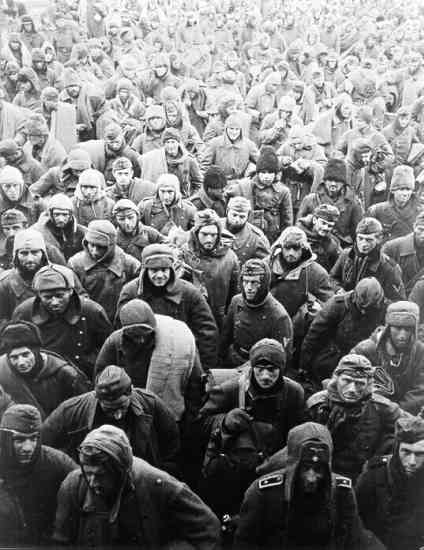The End at Stalingrad: 20th January – 2nd February 1943
Disease also began to spread. As their strength waned the soldiers’ immune systems broke down, and the absence of nutritious food accentuated this fact. Typhus and dysentery were rife, along with innumerable cases of frostbite. The Russians did not have to subjugate the pocket, the forces of nature, starvation and disease were doing it for them. In the Fuhrers headquarters the struggle at Stalingrad had assumed a mythological image far from the reality in the gutted city. The German people were spared the truth and a stream of orders telling Paulus to fight to the last man and to the last bullet flowed to Stalingrad. Hitler tried to conjure up the image of a heroic German soldier holding the Russian hordes on the Volga so far away from home. The reality was that the remnants of his battered army were disease and lice ridden, surrounded on all sides 250 miles away from help. As January 1943 dawned the reality began to hit many officers and men of 6th Army.
{default}The staff officers tried to justify their situation by saying that many Russian formations were being tied down around Stalingrad, and that their absence elsewhere was allowing a new front be constructed to the west. The men of 6th Army gave flight to more fancy stories. Divisions that had air landed at Kalach, an SS Panzer Corps that was a few miles away from the edge of the Kessel, none of these fanciful stories were true but they gave some comfort to men who had probably never in their lives been so alone. The rate of attrition inside the pocket was starting to take its toll on the battered divisions. On the 28th December 1942 the 76th Infantry Division, for example, was reduced to 35% effective fighting strength. Even the Panzer Divisions had been mauled to such an extent that in some battalions of the 16th Panzer Division the fighting strength had dropped to 10%. Despite this, the Germans had good, entrenched positions, and the Russians tried to get them to surrender on 9th January 1943. Stalin had ordered Rokossovsky to eliminate the pocket on the 3rd January. Hitler flatly refused and Paulus again received the order to stand and fight to the last man.
Operation Ring, the final subjugation of the Kessel, began on the 10th January 1943. 212,000 well equipped and well fed Russian soldiers faced about 191,000 encircled hungry, cold and ill supplied German troops. Those units stationed on the west of the pocket received the first staggering blows as thousands of guns and Katyusha rocket launchers erupted into flame. According to the 6th Army’s war dairy, the 76th Infantry Division had been reduced to 600 men from a pre-Stalingrad strength of 10,000! As the Russians pressed on, the air link itself became threatened. Russian artillery was within range of Pitomnik airfield, the primary airfield for supplies, and this had fallen into their hands by the 14th January. Stalingrad’s other airfield, Gumrak, was under constant bombardment. When Gumrak fell on the 21st all hope was now lost. What was left of the 6th Army shuffled its way into the ruins of Stalingrad. Supply now relied on the dropping of parachute canisters, but due to the Russian advance these more often than not fell into the Russian lines.
By the 30th January, the tenth anniversary of the Nazis coming to power, Paulus sent a telegram of congratulation to Hitler. In the celebratory speech heard by radios in Stalingrad Goering said "Rising above the gigantic battle like a mighty monument is Stalingrad. One day it will be recognized as the greatest battle in our history…" the men of 6th Army knew it was their epitaph. Up to that point discipline had held, but now many were contemplating surrender. Emaciated and flea ridden with thin uniforms and straw shoes many German, Romanian, Italian and Croatian men went into captivity and the unknown. As discipline collapsed, so did all sense of coherent behaviour. General Stempel, commanding the 371st Division, shot himself in the head; General Drebber of the 297th Division took the 1,800 survivors of his 10,000 man 297th Division, and led them into Soviet captivity, and General Hartmann, in charge of the 71st Division, stood erect on a railroad embankment and fired into the Russian lines, until he was cut down.

German Prisoners
Paulus repeatedly asked for permission to surrender and save what was left of his men. He argued that they had done their duty and through their sacrifice had allowed the German armies in the Caucasus to retreat. Hitler refused again and again, and even promoted Paulus to Field Marshal on the 30th of January in an attempt to get him to stand and die with his men, as no Prussian Field Marshall had ever been captured. On the 31st the Russians entered Paulus’ HQ at the Univermag department store. Paulus surrendered to the disgust of Hitler. As the Kessel had been split a few days earlier the only outposts of German resistance were in the factory district in the north of the city under General Strecker. On the 2nd February 1943 Strecker sent this telegram to Hitler "Eleventh Corps and its divisions have fought to the last man against vastly superior forces. Long live Germany."

